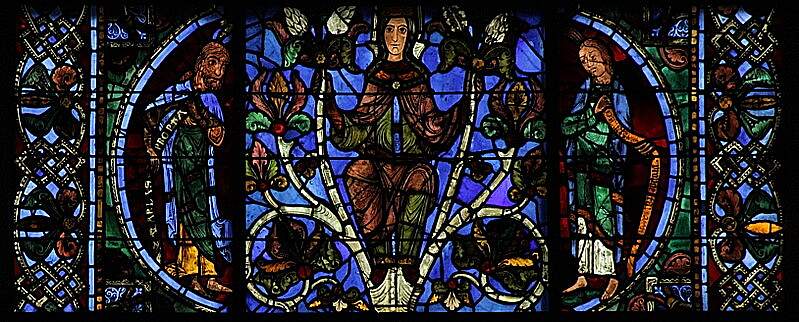
Jesse Tree, Chartres Cathedral window (14th c.), detail: The Virgin Mary with the prophet Zachariah (left), and the prophet Daniel (right)
Commons wikimedia.
The Old Testament announces Christ in a veiled and prophetic fashion, and also sketches the figure of His mother, the Virgin Mary in Genesis (just after the Fall, Gen 3:15) or in Isaiah, for example. The articles devoted to the prefiguration of Mary in the Old Testament are treated in the sections “Holy Scripture” and “Doctrine” of the Marian Encyclopedia. This article speaks about the prefiguration of Mary from the perspective of salvation, according to the book on this topic by Vladimir Lossky.
The Old Testament is not merely a series of foreshadowings of Christ that became decipherable after the Incarnation. It is above all the history of humanity’s preparation for Christ’s coming, a period in which human freedom was constantly put to the test by God.
Noah’s obedience, Abraham’s sacrifice, the exodus of God’s people led by Moses across the desert, the Law, the prophets, a series of divinely ordained events during which human beings remained faithful to their promise, but later failed and suffered chastisement, including captivity and the destruction of the first temple were all part of this preparation. The entire sacred tradition of the Jews is the story of fallen humanity’s slow and laborious progress toward the “fullness of time”, when the Angel would be sent to announce the Incarnation to the virgin chosen by God and to receive from her lips the human assent which enabled the divine plan of salvation to be accomplished.
“The name of the Mother of God embraces the whole history of divine economy in the world.”
Further, according to the words of Saint John Damascene, the “name of the Mother of God contains the whole history of the divine economy in the world” (De fide ort. III). This divine economy, which prepares human beings for the Incarnation of the Son of God, is not one-sided: the divine will is not imposing itself onto human history. In His economy of salvation, the Wisdom of God adapts to the fluctuations of the human will and to the human responses to the divine call.It is thus that Wisdom builds her house across generations of the just in the Old Testament: the house of Wisdom being the Blessed Virgin’s most pure nature, in which the Word of God becomes incarnate and dwells. Mary responds to the angel’s message, “Behold, I am the handmaid of the Lord; let it be done to me according to Your Word” (Lk 1:38). She thus resolves the tragedy of fallen humanity. All that God requires of human freedom after the Fall is accomplished. Now at last the work of the Redemption which only the Incarnate Word could bring about can take place.
Like other men, like Saint John the Baptist, whose conception and birth the Church also celebrates, the Blessed Virgin was born under the rule of original sin, carrying with all of humanity the responsibility of the Fall. But sin was never actualized in her person; the sinful heredity of the Fall had no control over her upright will. She represents the peak of holiness which could ever be attained by one of Adam’s descendants before Christ, under the conditions of the Old Testament.
She was without sin, free from its universal domination, pure and innocent of all seduction among a humanity enslaved by the prince of the world. Nevertheless, she was not placed above human history to serve God’s particular design, but lived out her unique vocation in the chain of history, in the common destiny of men awaiting their salvation.
Finally, the Mother of God represents not merely the summit of sanctity within the Old Testament. She surpasses the highest summits within the New Covenant and realizes the greatest sanctity which the Church can attain.
Excerpt from: V. Lossky, In the Image and Likeness of God, (À l’Image et à la ressemblance de Dieu) Aubier-Montagne, 1967
- About the Virgin Mary in Sacred Scripture, in the Marian Encyclopedia
- About the Dogmatic Constitution Lumen Gentium, from the Second Vatican Council, in the Marian Encyclopedia
The articles in the section “The Old Testament, Pathway to Mary” propose a reflection on the Covenant and the way in which the Virgin Mary has entered into the renewal of Creation through her motherhood. They follow the adventures of the Hebrew people and show the way in which the Virgin Mary enters salvation history and accomplishes the prophecies of Genesis, of Isaiah, and of Micah (Lumen Gentium, Second Vatican Council).
Vladimir Lossky et l'équipe de MDN